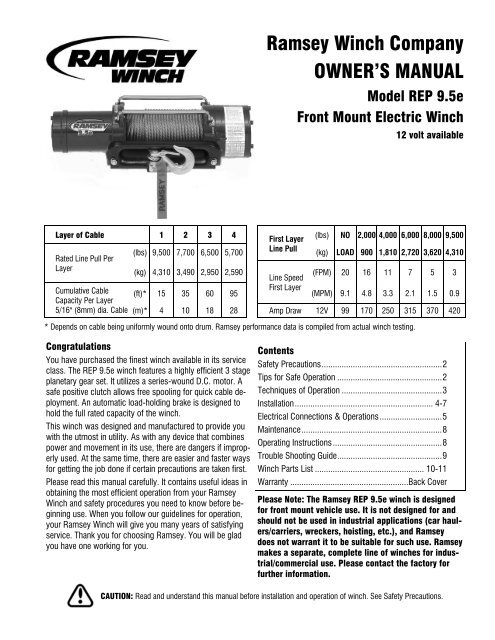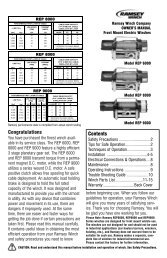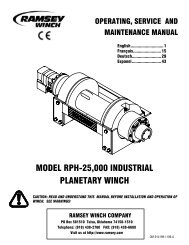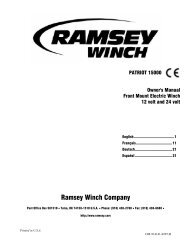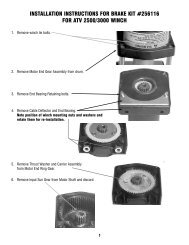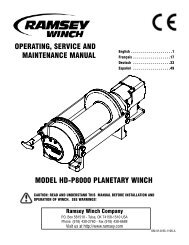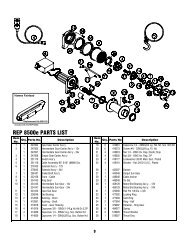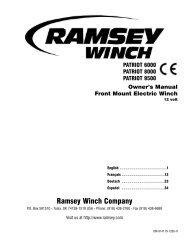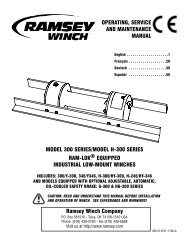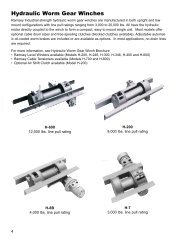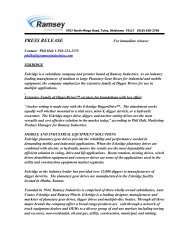Ramsey Winch Company OWNER'S MANUAL
Ramsey Winch Company OWNER'S MANUAL
Ramsey Winch Company OWNER'S MANUAL
- No tags were found...
You also want an ePaper? Increase the reach of your titles
YUMPU automatically turns print PDFs into web optimized ePapers that Google loves.
<strong>Ramsey</strong> <strong>Winch</strong> <strong>Company</strong>OWNER’S <strong>MANUAL</strong>Model REP 9.5eFront Mount Electric <strong>Winch</strong>12 volt availableLayer of Cable 1 2 3 4First Layer(lbs) NO 2,000 4,000 6,000 8,000 9,500(lbs) 9,500 7,700 6,500 5,700Line PullRated Line Pull Per(kg) LOAD 900 1,810 2,720 3,620 4,310Layer(kg) 4,310 3,490 2,950 2,590Line Speed(FPM) 20 16 11 7 5 3Cumulative CableFirst Layer(ft)* 15 35 60 95Capacity Per Layer(MPM) 9.1 4.8 3.3 2.1 1.5 0.95/16" (8mm) dia. Cable (m)* 4 10 18 28 Amp Draw 12V 99 170 250 315 370 420* Depends on cable being uniformly wound onto drum. <strong>Ramsey</strong> performance data is compiled from actual winch testing.CongratulationsYou have purchased the finest winch available in its serviceclass. The REP 9.5e winch features a highly efficient 3 stageplanetary gear set. It utilizes a series-wound D.C. motor. Asafe positive clutch allows free spooling for quick cable deployment.An automatic load-holding brake is designed tohold the full rated capacity of the winch.This winch was designed and manufactured to provide youwith the utmost in utility. As with any device that combinespower and movement in its use, there are dangers if improperlyused. At the same time, there are easier and faster waysfor getting the job done if certain precautions are taken first.Please read this manual carefully. It contains useful ideas inobtaining the most efficient operation from your <strong>Ramsey</strong><strong>Winch</strong> and safety procedures you need to know before beginninguse. When you follow our guidelines for operation,your <strong>Ramsey</strong> <strong>Winch</strong> will give you many years of satisfyingservice. Thank you for choosing <strong>Ramsey</strong>. You will be gladyou have one working for you.ContentsSafety Precautions......................................................2Tips for Safe Operation ...............................................2Techniques of Operation .............................................3Installation .............................................................. 4-7Electrical Connections & Operations ............................5Maintenance...............................................................8Operating Instructions .................................................8Trouble Shooting Guide...............................................9<strong>Winch</strong> Parts List ................................................. 10-11Warranty .....................................................Back CoverPlease Note: The <strong>Ramsey</strong> REP 9.5e winch is designedfor front mount vehicle use. It is not designed for andshould not be used in industrial applications (car haulers/carriers,wreckers, hoisting, etc.), and <strong>Ramsey</strong>does not warrant it to be suitable for such use. <strong>Ramsey</strong>makes a separate, complete line of winches for industrial/commercialuse. Please contact the factory forfurther information.CAUTION: Read and understand this manual before installation and operation of winch. See Safety Precautions.
Safety Precautions To Guard AgainstPossible Injury…until all the cable except a few feet is in. Disconnect theremote control switch and finish spooling in cable byrotating the drum by hand with clutch disengaged. Onhidden winches, spool in cable under power using suppliedhook strap.A minimum of five wraps of cable around the drum barrel isnecessary to hold the rated load. Cable clamp in not designedto hold the load.A. Keep yourself and others a safe distance to the side ofthe cable when pulling under load.B. Don't step over a cable, or near a cable under load.C. Use supplied hook strap when handling hook for spoolingwire rope.D. Don't move the vehicle to pull a load on the winch cable.This could result in cable breakage.E. Use a heavy rag or gloves to protect hands from burrswhen handling winch cable.F. Apply blocks to wheels when vehicle is on an incline.G. <strong>Winch</strong> clutch should be disengaged when winch is notin use and fully engaged when in use.H. Modification, alteration or deviation to the winch shouldonly be made by <strong>Ramsey</strong> <strong>Winch</strong> <strong>Company</strong>.I. Keep the duration of your pulls as short as possible. Ifthe motor becomes uncomfortably hot to the touch, stopand let it cool for a few minutes. Do not pull more thanone minute at or near rated load. Do not maintain powerto the winch if the motor stalls. Electric winches are forintermittent usage and should not used in constant dutyapplications.J. Disconnect the remote control switch from the winchwhen not in use. A <strong>Ramsey</strong> Part No. 282053 safety onoffswitch in your vehicle is recommended.K. Note: Do not use winch in hoisting applications due torequired hoist safety factors and features.L. Do not exceed maximum line pull ratings shown in tables.Shock loads must not exceed these ratings.M. To respool correctly, it is necessary to keep a slight loadon the cable. This is accomplished by (wearing gloves)holding the cable with one hand and the remote controlswitch with the other, starting as far back and in thecenter as you can, walking up keeping load on the cableas the winch is powered in. Do not allow the cable toslip through your hand and do not approach the winchtoo closely. Turn off the winch and repeat the procedure2Tips for Safe OperationDon't underestimate the potential danger in winching operations.Neither should you fear them. Do learn the basic dangersand avoid them.The uneven spooling of cable, while pulling a load, is not aproblem, unless there is cable pileup on one end of drum. Ifthis happens, reverse the winch to relieve the load and moveyour anchor point further to the center of the vehicle. Afterthe job is done you can unspool and rewind for a neat lay ofthe cable.Store the remote control switch inside your vehicle where itwill not become damaged. Inspect it before you plug it in.When ready to begin spooling in, plug in remote controlswitch with clutch disengaged. Do not engage clutch withmotor running.Never connect the hook back to the cable. This causes cabledamage. Always use a sling or chain of suitable strength asshown in the illustrations.Observe your winch while winching, if possible, while standingat a safe distance. If you use vehicle drive to assist, stopand get out every few feet to assure the cable is not piling upin one corner. Jamming cable can break your winch.Do not attach tow hooks to winch mounting apparatus. Theymust attach to vehicle frame.When double lining during stationary winching, the winchhook should be attached to the chassis of the vehicle.Since the greatest pulling power is achieved on the innermostlayer of your winch, it is desirable to pull off as muchline as you can for heavy pulls (remember, you must leave 5wraps min. on the drum). If this is not practical, use a snatchblock and double line arrangement (see illustration).Neat, tight spooling avoids cable binding, which is causedwhen a load is applied and the cable is pinched between twoothers. If this happens, alternately power the winch in andout a few inches. Do not attempt to work a bound cable underload; free by hand.
Techniques of OperationThe best way to get acquainted with how your winch operatesis to make a few test runs before you actually need to use it.Plan your test in advance. Remember you hear your winch aswell as see it operate. Get to recognize the sound of lightsteady pull, a heavy pull, and sounds caused by load jerking orshifting. Soon you will gain confidence in operating your winchand its use will become second nature with you.Your winch will not only pull your vehicle up or ease your vehicledown a steep grade, it will also pull another vehicle or aload while your vehicle is anchored in a stationary position.The following sketches show you a few techniques.For basic self-recovery, anchor to a tree or heavyrock. When anchoring to a tree, always use a treetrunk protector.When pulling a heavy load, place a blanket, jacket or tarpaulinover the cable five or six feet from the hook. It will slow thesnap back in the event of a broken cable. Also open the vehiclehood for additional protection.Use the vehicle wheel power to help the winch, but don't overtakethe winch line. Plan your pull. You can't always hook upand pull out in one step. Examine all the areas for anchoringpossibilities as well as leverage situations, direction and goal.Stakes driven in solid earth and chained togethermake a good anchor point for self-recovery when nosolid anchor point is available.For a direct pull of 2000 lbs., hitch truck to a tree orsolid anchor, and take out of gear.<strong>Winch</strong>es equipped with cable guide fairleads can pullfrom several directions. Pull from an angle only tostraighten up the vehicle-otherwise you can damagestructural members or other parts of your vehicle andcause excess cable buildup on one end of the winchdrum.For a solid anchor, bury a log with earth or sand orplace it in a deep ravine.To double the pull, use 2-part line with snatch blockand tie off to chassis. Take out of gear.3
FIGURE 4Electrical Connections and OperationsFor normal self-recovery work, your existing electrical systemis adequate. Your battery must be kept in good condition.A fully charged battery and proper connections are essential.Run the vehicle engine during winching operations tokeep battery charged.The remote control switch is waterproof. It has push buttonstations on either side. It is designed this way to preventquick winch reversals, which lead to solenoid failure. Makesure the motor has stopped fully before reversing. To actuatewinch simply plug remote control switch into receptacle inblack solenoid cover of winch.Run winch forward and reverse to check connection and todetermine winch operating directions. Snap appropriate "IN"and "OUT" disc into proper thumb cavity. The switch is alsocolor coded to aid you in not having to guess at the directionyour winch will run. DO NOT LEAVE SWITCH PLUGGED INWHEN WINCH IS NOT IN USE.Route red and black battery cables up to battery. CAUTION:BE SURE BATTERY CABLES ARE NOT DRAWN TAUTACROSS ANY SURFACES WHICH COULD POSSIBLY DAM-AGE THEM. Connect red cable to positive (+) battery terminaland black cable to negative (-) terminal.5
Repositioning Shifter for Specific Bull Bar ApplicationsNote: The shifter is positioned correctly for most applications. It will only need to be repositioned as necessary for specificbull bar applications.Refer to the Parts List and Exploded Parts Diagram for your specific winch elsewhere in this owner’s manual.1. Position winch as shown in Figure 5. Remove screws from tiebars. You may be able to loosen the screws at the motorend without removing them. Pull the Gear Housing assembly from the drum and shaft and set it down on the workbench with the Gear Housing Cover up. Remove the drum bushing from the Gear Housing assembly or the end of thedrum. Set aside.2. Remove (6) capscrews from the Gear Housing Cover. Holding the Gear Housing Cover over the Gear Housing assembly,flip it over and set it on the workbench.FIGURE 53. Gently lift the Gear Housing assembly,working the gears, bushings, etc. thatare inside the Gear Housing out so thatthey are left stacked on the workbench.See Figure 7.4. Turn the Gear Housing assembly overand set on workbench. Remove the Retainer(item #38) by removing six capscrews(item #22) from Gear End Bearing(item 16). Once the retainer is removed,the Ring Gear (items #15 &31),Cam Ring (item #36), and Locking Ring(item #35) can be lifted off the endbearing.Remove the six springs (item #39) fromthe end bearing.22363916381535FIGURE 61524018401341143121402910624FIGURE 7
5. Determine position shifter knob needs tobe for your application. Note: Shifterknob cannot be positioned too low or itwill interfere with the feet on the GearEnd Bearing (see Range of Position inFigure 8).6. To position the shifter knob, place lockingring in end bearing with stop postapproximately 180° from where shifterknob needs to be positioned. Place camring over locking ring in proper positionand confirm that shifter knob will movefrom engaged to disengaged positionwithout interference. Mark position ofstop post on end bearing.CAM RINGSHIFTERKNOBRANGE OF POSITIONFOR SHIFTER KNOBEND BEARINGSTOP POST ONRING GEAR LOCKFIGURE 87. Remove cam ring and locking ring from end bearing. Insert springs (item #39) into end bearing. When you replace thelocking ring (item #35) over the springs, be sure the springs compress down into their recesses, and don’t bend sideways.8. Reassemble Gear Housing as shown in Figure 7. Make sure locking ring is positioned with stop post at marked location.The capscrews (item #22) for the retainer should be tightened to 40-45 in-lbs. Do not over-tighten.9. Place Gear Housing over the stacked gears, etc. that you removed in step 3. Gently work the housing over the stack,turning it as needed to mesh the planetary gears with the ring gear in the housing. Once they are all in the housing, flipthe assembly over. Align the Gear Housing Cover and gasket with the holes in the ring gear. Replace the (6) capscrewsthat hold the Gear Housing Cover onto the Gear Housing. Tighten securely.10. Move the Shifter to the Disengaged position.11. Turn the Gear Housing over and set it on thework bench with the Gear Housing Coverdown. See Figure 9.12. Install the drum bushing into the Gear Housing,confirming that the slot in the bushing isaligned with the key in the end bearing. Pickup the rest of the winch (drum and motorend), and holding the drum, lower the winchonto the gear end. Stab the shaft into thegear end--you may need to turn the drumslightly to get the shaft to go all the way in.13. Place the tiebars on the motor end and gearend and fasten using (4) screws. Tightensecurely.14. Once the winch is reassembled, turn it sothat it is sitting on its feet. Confirm that thecable will freespool when the shifter is in theDisengaged position. Connect up the winchtemporarily and confirm that the cablespools when the shifter is in the Engagedposition.FIGURE 97
MaintenanceAll moving parts in the winch are permanently lubricated withhigh temperature lithium grease at the time of assembly.Under normal conditions factory lubrication will suffice.Lubricate cable periodically using light penetrating oil. Inspectfor broken strands and replace if necessary with <strong>Ramsey</strong>part number listed in Parts List. If the cable becomesworn or damaged, it must be replaced.Corrosion on electrical connections will reduce performanceor may cause a short. Clean all connections especially in theremote control switch and receptacle. In salty environmentsuse a silicone sealer to protect from corrosion.Operating InstructionsThe winch clutch allows rapid unspooling of the wire rope forhooking onto the load or anchor point. The clutch shifter tabis located on the gear-housing end of the winch and operatedas follows:1. To disengage the clutch, move the clutch shifter tab tothe "OUT" position. Wire rope may now be free-spooledoff the drum.2. To engage the clutch, move the clutch shifter tab to the"IN" position. The winch is now ready for pulling.To minimize corrosion of the internal motor components thatmay occur due to condensation, power the winch in or outperiodically. Energizing the motor will generate heat, whichwill help dissipate any moisture buildup in the motor. Thisshould be performed at periodic intervals (such as with eachoil change to your vehicle). Note: Refer to the TroubleshootingGuide if the motor has been submerged.Cable InstallationUnwind the new cable by rolling it out along the ground, toprevent kinking. Remove old cable and observe the mannerin which it is attached to the cable drum flange.Before installing the new cable assembly, make sure end ofcable is squarely cut and wrapped with tape to prevent fraying.Form a short 90° bend (approximately ½" long) in theend of the cable.Position the cable drum so that the large 13/32" diameterhole in the motor end drum flange is approximately on thetop. Insert the bent end of cable into the 13/32" hole in thedrum flange and then carefully run the winch in the "reel in"direction approximately ¾ revolution until the ¼" diameterthreaded hole in the drum flange is on top. Secure the cableto the drum flange using cable anchor and capscrew shownin the parts drawing. Securely tighten the capscrew, but donot over-tighten.Wind 5 wraps of cable onto the drum. <strong>Winch</strong> on the rest ofthe cable by pulling in a light load to keep the tension constant.Allow the cable to swivel by using a length of chain ora block between the cable hook and the load.8
Troubleshooting GuideCONDITION POSSIBLE CAUSE CORRECTIONMOTOR RUNS IN ONLY ONEDIRECTION(1) Defective solenoid or stuck solenoid (1) Jar solenoid to free contacts. Check by applying 12volts to coil terminal (it should make an audible clickwhen energized).(2) Defective remote control switch (2) Disengage winch clutch, remove remote controlswitch plug from the socket and jump pins at 8 and 4o’clock. Motor should run. Jump pins at 8 and 10o’clock. Motor should run.MOTOR RUNS EXTREMELYHOTMOTOR RUNS, BUT WITHINSUFFICIENT POWER, ORWITH LOW LINE SPEED(1) Long period of operation (1) Cooling-off periods are essential to prevent overheating.(1) Insufficient battery (1) Check battery terminal voltage under load. If 10 voltsor less, replace or parallel another battery to it.(2) Bad connection (2) Check battery cables for corrosion; clean and grease.(3) Insufficient charging system (3) Replace with larger capacity charging system.MOTOR RUNS, BUT DRUMDOES NOT TURN(1) Clutch not engaged (1) If clutch engaged but symptom still exists, it will benecessary to disassemble winch to determine causeand repairMOTOR WILL NOT OPERATE (1) Defective solenoid or stuck solenoid (1) Jar solenoid to free contacts. Check solenoid by applying12 volts to coil terminal (it should make anaudible click when energized).(2) Defective remote control switch (2) Disengage winch clutch, remove remote controlswitch plug from the socket and jump pins at 8 and 4o’clock. Motor should run. Jump pins at 8 and 10o’clock. Motor should run.(3) Defective motor (3) If solenoids operate, check for voltage at armaturepost; replace motor(4) Loose connections (4) Tighten connections on bottom side of hood and onmotorMOTOR WATER DAMAGED(1) Submerged in water or water fromhigh pressure car wash(1) Allow to drain and dry thoroughly, then run motorwithout load in short bursts to dry windings.CABLE DRUM WILL NOTFREESPOOL OR IS DIFFI-CULT TO FREESPOOL(1) Clutch not disengaged (1) Check clutch operation according to nameplate. Makesure clutch shifter knob is fully at “OUT” position.(2) <strong>Winch</strong> not mounted squarely causingend bearing to bind drum(2) Check mounting to see that installation instructions onpage 4 have been followed.(3) Some or all of the (6) 414861 flathead capscrews attaching the479007 ring gear retainer are tootight(3) Remove the gear housing cover, 413018, and allgears from inside the gear housing. Disengage theclutch and check to see that the ring gear will rotateby hand. If it will not, using a hex (allen) wrench,slightly loosen all the capscrews and then snugly retightenthem in cross-cross pattern, but do not overtighten. The ring gear must rotate by hand. Reassemblethe winch.9
Hawse FairleadReplacement Kit #251152REP 9.5e PARTS LISTItemItemQty. Part No. DescriptionNo.No.Qty. Part No. Description1 1 247009 Gear Carrier Ass’y.-Input 22 1 414830 Capscrew 1/4-20NC x 3/8 Lg. Soc. Button Hd.2 1 247022 Gear Carrier Ass’y-Intermediate 23 6 414861 Capscrew 1/4-20NC x 3/4 Lg. Flat Hd. Soc. NYLOK3 1 247023 Gear Carrier Ass’y-Output 24 6 414868 Capscrew 1/4-20NC x 2-1/2 Lg. Flat Hd. Soc. NYLOK4 1 251110 Switch Ass’y 25 4 418035 Nut 3/8-16NC Hx. Reg. Z/P5 1 251118 Cable Assembly 26 5 418177 Lockwasher-3/8 Med. Sect. Z/P6 1 278158 Solenoid Ass’y 27 4 418181 Washer-Flat 3/8 ID S.A.E. Z/P7 1 289141 Cable-Ground 28 1 424023 Clamp8 1 296181 Brake/Shaft Ass’y 29 1 442208 Gasket-Cover9 1 296589 Motor Assembly 30 1 442219 Gasket-Ring Gear10 1 328138 Cover-Gear Housing 31 1 444077 Gear-Ring, Input11 1 332193 Drum-Cable 32 1 448046 Cable Anchor12 1 334147 Gear-Intermediate Sun 33 2 448049 Tie Bar13 1 334154 Gear-Input Sun 34 1 470053 Roll Pin-1/8 Dia. x 3/8 Lg.14 1 334197 Gear-Output Sun 35 1 477002 Locking Ring15 1 334171 Gear-Ring, Output 36 1 477013 Cam Ring16 1 338332 End Bearing 37 2 477004 Ring-Half17 2 412056 Bushing-Drum 38 1 479007 Retainer-Ring Gear18 1 412061 Bushing-Shaft 39 6 494077 Spring19 4 414316 Capscrew 3/8-16NC x 1-1/4 Lg. Hx. Hd. Gr.5, Z/P 40 6 518020 Thrust Washer20 1 414370 Capscrew 3/8-24NF x 1/2 HX HD ZP GR5 41 1 518027 Thrust Disc21 4 414823 Capscrew 1/4-20NC x 3/4 Lg. Soc. Button Hd. 42 1 452005 Shifter Lever10
Solenoid Assembly Parts List278158 (12V)Note: All unidentified hardware comessupplied with the solenoid.ItemNo. Qty. Part No. Description1 1 289015 Wire Assembly—Battery Red 72"2 1 289091 Wire Assembly—Black 16 Ga. x 1-1/2” Lg.3 1 289092 Wire Assembly—Black 6 Ga. x 3-1/2” Lg4 3 289171 Wire Assembly—Motor Lead5 1 289208 Wire Assembly—Ground6 2 364002 Strap—Copper7 1 408102 Bracket8 1 413024 Cover—Solenoid9 3 414053 Capscrew 1/4—20NCx1-1/4Lg.Hx.Hd. Z/P11 7 416216 Screw #10—24NCX 1/2” Lg. Rd. Hd. Z/P12 2 416227 Screw #10—24NCX 3/4” Lg. Truss Hd. Black13 6 418004 Nut—Hx. Reg. #10—24NC Z/P14 6 418014 Nut—Hx. Reg 1/4—20NC Z/P16 3 418140 Washer #10 SAE Flat Z/P17 2 418141 Lockwasher #10 Med. Sect. Z/P18 3 418149 Lockwasher 1/4 Med. Sect. Z/P20 3 418411 Nutsert #10—24NC21 3 418514 Spacer22 1 430013 Connector Female—Molded23 2 440071 Terminal Tab24 2 440110 Solenoid25 1 440111 Strap—Copper26 1 482029 Cover—Female Connector11
Warranty Information<strong>Ramsey</strong> <strong>Winch</strong>es are designed and built to exacting specifications. Care and skill go into every winch we make.If the need should arise, warranty procedure is outlined on the back of your self-addressed, postage paid warrantycard. Please read and fill out the enclosed warranty card and send it to <strong>Ramsey</strong> <strong>Winch</strong> <strong>Company</strong>. If youhave any problems with your winch, please follow instructions for prompt service on all warranty claims.Limited Lifetime Warranty<strong>Ramsey</strong> <strong>Winch</strong> offers a limited lifetime warranty for each new <strong>Ramsey</strong>winch against manufacturing defects in workmanship and materials on allmanufactured components.Warranty registration cards for each winch must be submitted at the timeof purchase or within 30 days. Warranty will only be valid for the originalpurchaser of the winch and installed on the vehicles with which they wereoriginally registered.New cable assemblies are warranted against defects in workmanship andmaterials. No warranty applies after initial use.All <strong>Ramsey</strong> mounting kits and other accessories carry a one year limitedwarranty against defects in materials and workmanship.This warranty is void if winch is used in commercial/industrial applicationsother than front mount self recovery.Electrical components consisting of motors, solenoids, wiring, wire connectors,and associated parts carry a limited 1-year warranty. Batteryisolators carry a 90-day limited warranty.The obligation under this warranty, statutory or otherwise, is limited to thereplacement or repair at the manufacturers factory, or at a point designatedby the manufacturer, of such part as shall appear to the manufacturer,upon inspection of such part, to have been defective in material orworkmanship. This Warranty does not obligate <strong>Ramsey</strong> <strong>Winch</strong> <strong>Company</strong>to bear the cost of labor or transportation charges in connection with thereplacement or repair of defective parts, nor shall it apply to a productupon which repairs or alterations have been made, unless authorized bythe manufacturer, or for equipment misused, neglected or improperlyinstalled.Important notice: To the fullest extent permitted by applicable law,the following are hereby excluded and disclaimed: 1. All warrantiesof fitness for a particular purpose; 2. All warranties of merchantability;3. All claims for consequential or incidental damages. Thereare no warranties that extend beyond the description that appearson the face hereof.Some states do not allow the above exclusions or disclaimers inconsumer transactions and as such this disclaimer/exclusion maynot apply to your particular case.To the extent such warranties of fitness for a particular purpose ormerchantability are deemed to apply to this product, they exist onlyfor so long as the express limited warranty elsewhere set forth is inexistence.<strong>Ramsey</strong> <strong>Winch</strong> <strong>Company</strong> makes no warranty in respect to accessories,same being subject to the warranties of their respective manufacturers.<strong>Ramsey</strong> <strong>Winch</strong> <strong>Company</strong>, whose policy is one of continuous productimprovement, reserves the right to improve any product through changesin design or materials as it may deem desirable without being obligated toincorporate such changes in products of previous manufacture.If field service at the request of the buyer is rendered and the fault is foundnot to be with <strong>Ramsey</strong> <strong>Winch</strong> <strong>Company</strong>’s product, the buyer shall pay thetime and expense of the field representative. Bills for service, labor or otherexpenses which have been incurred by the buyer without express approvalor authorization by <strong>Ramsey</strong> <strong>Winch</strong> <strong>Company</strong> will not be accepted.This warranty gives you specific legal rights and you may also have otherlegal rights which vary from state to state.RAMSEY WINCH COMPANYP.O. BOX 581510 • TULSA, OKLAHOMA 74158-1510 • USAPHONE (918)438-2760 • FAX (918)438-6888Visit us at http://www.ramsey.com12914162-0107-D


